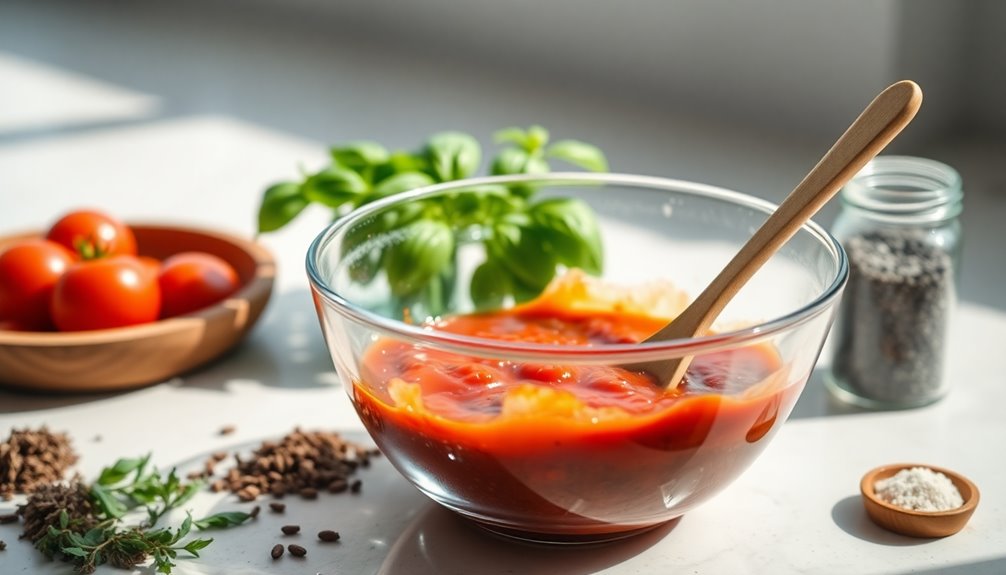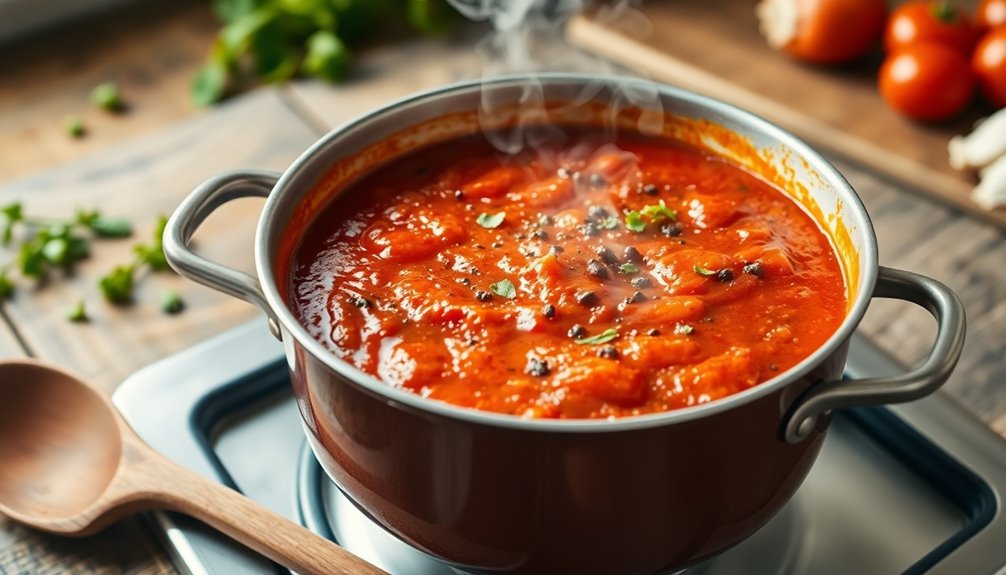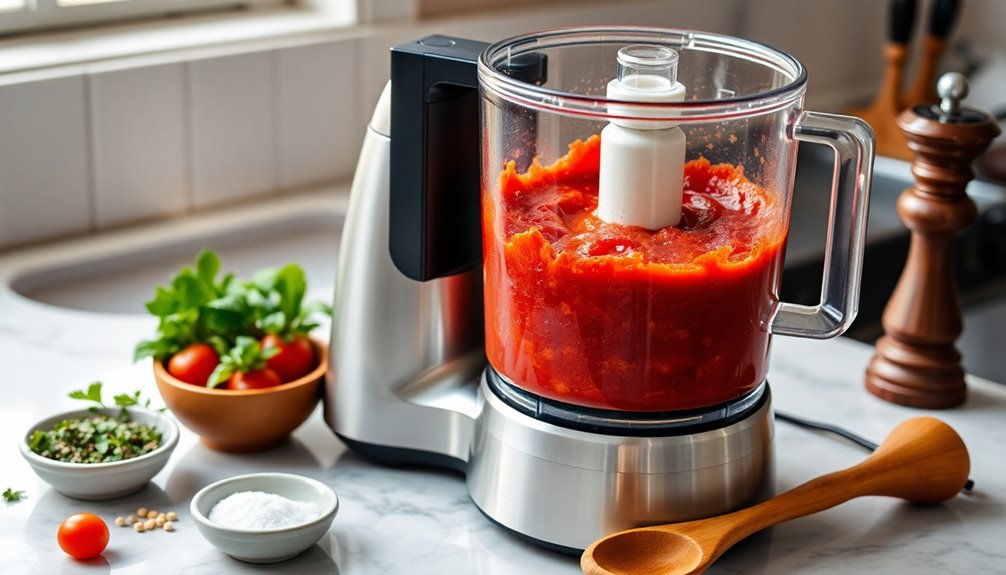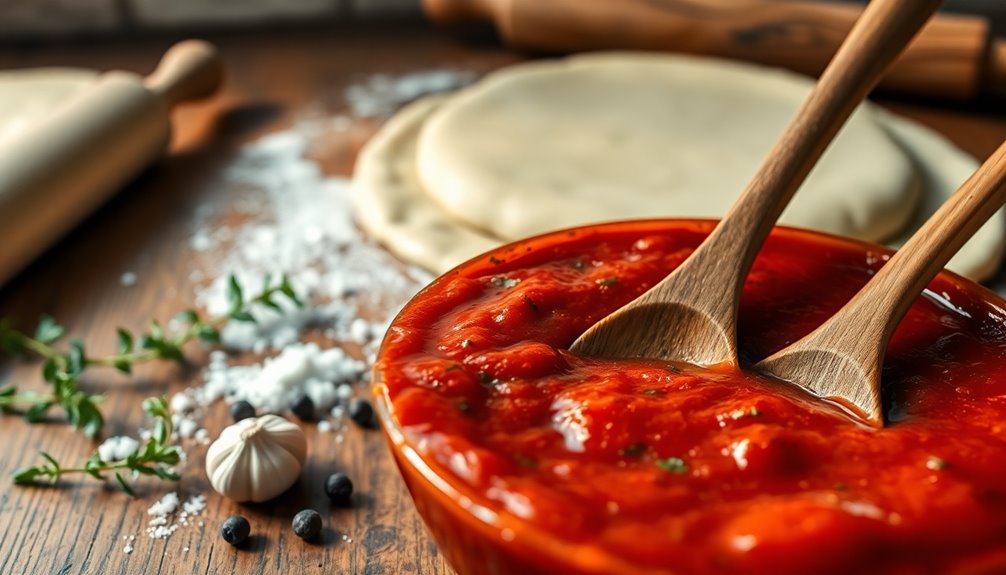When you think about pizza, the sauce often plays a crucial role in elevating the entire experience. You might wonder how to create a balanced pizza sauce that complements your toppings without overpowering them. It doesn't take long to whip up a basic recipe, but the right blend of ingredients can make all the difference. As you explore the essentials, you'll find that there are variations and techniques that can enhance your sauce further, leading to a flavorful discovery that could redefine your pizza nights. What ingredients will you experiment with?
Key Takeaways
- Combine tomato sauce and tomato paste for a rich base, then add olive oil, garlic, and herbs like oregano and basil.
- Simmer the mixture on low heat for about 20 minutes to allow flavors to meld together.
- Adjust seasoning to taste with garlic salt, optional sugar, or red pepper flakes for desired flavor balance.
- Blend the sauce until smooth for optimal texture and even flavor distribution.
- Store in an airtight container in the refrigerator for up to 2 weeks or freeze for up to 3 months.
History

The history of pizza sauce is fascinating, especially when you consider its origins in late 19th-century Italy.
In Naples, flatbreads topped with tomatoes became popular, leading to the creation of traditional Neapolitan pizza sauce. This sauce typically features San Marzano tomatoes, prized for their sweetness and low acidity, grown in the volcanic soil of Mount Vesuvius.
The classic blend of tomatoes, garlic, olive oil, and herbs like oregano and basil developed into a robust flavor profile that set a global standard.
As pizza spread to the United States, the mid-20th century saw a surge in Italian-American cuisine, giving rise to various regional sauce styles.
Today's pizza sauces incorporate diverse culinary influences, reflecting evolving tastes and preferences.
Recipe

Pizza Sauce Recipe
Making your own pizza sauce at home isn't only quick and easy, but it also allows you to tailor the flavors to your liking. In just 5 minutes, you can whip up a delicious sauce that will elevate your homemade pizza to the next level.
This simple recipe combines the rich flavors of tomato sauce and tomato paste with aromatic seasonings to create a thick and flavorful base for your favorite toppings.
The beauty of this pizza sauce lies in its versatility. You can easily adjust the seasonings to match your palate, whether you prefer a hint of spice or a more herbaceous blend.
Once prepared, this sauce can be stored in the refrigerator for up to two weeks or frozen for later use, ensuring you always have a quick and tasty sauce on hand for your pizza nights.
Ingredients:
- 1 cup tomato sauce
- 1/2 cup tomato paste
- 1 teaspoon oregano
- 1/2 teaspoon garlic salt
- 1/4 teaspoon pepper
Cooking Instructions:
In a medium bowl, combine the tomato sauce and tomato paste until well blended.
Add in the oregano, garlic salt, and pepper, stirring until all ingredients are fully incorporated.
Taste the sauce and adjust the seasonings as desired to suit your flavor preferences.
Once mixed, your pizza sauce is ready to be spread on your pizza dough or stored for later use.
Extra Tips:
For a more complex flavor, consider adding additional herbs like basil or thyme, or even a pinch of red pepper flakes for some heat.
If you prefer a smoother sauce, you can blend the mixture in a food processor for a finer consistency.
Remember to let your sauce cool completely before storing it in an airtight container, and always label your frozen sauce with the date for easy tracking.
Enjoy experimenting with different flavor combinations!
Cooking Steps

To make your pizza sauce, you'll start by gathering all the ingredients you need.
Then, blend the tomato sauce and paste until smooth before adding seasonings to taste.
Once that's done, simmer the mixture for about 20 minutes to let the flavors meld beautifully.
Step 1. Gather All Ingredients Needed

Gather all the essential ingredients for your pizza sauce to kick off your cooking adventure.
You'll need tomato sauce, tomato paste, and some olive oil to create that perfect base.
Don't forget garlic, oregano, and basil for flavor, along with salt and pepper to season it just right.
If you want to balance the acidity, consider adding a teaspoon of sugar or honey.
For an extra kick, toss in some red pepper flakes, and if you're feeling adventurous, include fennel seeds or anise to enhance the flavor profile.
Make sure you have measuring spoons and a mixing bowl handy for efficiently combining everything.
With these ingredients ready, you're all set to create delicious pizza sauce!
Step 2. Simmer for 20 Minutes

Now that you've got all your ingredients ready, it's time to let them work their magic. Set your stove to low heat and let the sauce simmer for about 20 minutes.
This cooking process allows the flavors to meld, creating a richer taste. Be sure to stir the sauce every few minutes to prevent it from sticking to the bottom of the pan or burning.
As it simmers, you'll notice the sauce thickening, which enhances its application on your pizza dough. If you've added dried herbs, crushing them beforehand helps release their essential oils, intensifying the flavors further.
Keep in mind that moderation in butter consumption is essential for heart health, especially if you plan to use a butter-based crust for your pizza.
Trust this simmering time to elevate your sauce to its full potential!
Step 3. Add Seasonings to Taste

Once your sauce has simmered and thickened, it's time to elevate its flavor by adding seasonings.
Start with a pinch of garlic salt or garlic powder to enhance the overall flavor profile of your pizza sauce. Next, incorporate dried oregano or Italian seasoning, as these potent herbs contribute richness.
To balance the acidity of the tomatoes, add a small amount of granulated sugar or honey. If you like a bit of heat, sprinkle in some red pepper flakes, starting with a small amount and adjusting to your taste.
Always taste your sauce as you go, allowing you to fine-tune the flavors to your preference before spreading it on the pizza dough. Additionally, consider your overall health and incorporate a balanced diet to complement your pizza night.
Enjoy creating your perfect pizza sauce!
Step 4. Blend Until Smooth

To achieve a smooth and velvety pizza sauce, blend the ingredients thoroughly using a food processor or immersion blender.
Combine all your sauce components—like tomato sauce, tomato paste, and seasonings—ensuring an even mix for optimal flavor distribution. Blend until no chunks remain, aiming for a texture with no pieces larger than 1/16th of an inch.
If you prefer a thicker sauce, consider blending for a shorter duration or using less liquid initially, adjusting as needed.
After blending, let the sauce sit for several hours to let the flavors meld, enhancing the overall taste.
Step 5. Taste and Adjust Seasoning

After blending your sauce to achieve that smooth texture, it's time to refine the flavors.
Start by tasting the sauce during cooking; this helps you decide if you need to adjust seasoning. If it's lacking sweetness or acidity, add sugar or vinegar as needed.
Incorporate dried herbs early to let their flavors develop, while adding fresh herbs towards the end for brightness.
If the sauce tastes flat, a splash of red wine or a pinch of citric acid can enhance the flavor profile and balance acidity.
For a robust flavor, gradually mix in crushed red pepper flakes, adjusting to your preferred spice level.
Final Thoughts

As you wrap up your pizza-making adventure, remember that this easy homemade sauce not only elevates your pizza but also invites your creativity in the kitchen.
This quick recipe takes just 5 minutes to prepare, combining tomato sauce, tomato paste, and delicious seasonings for the best flavor. Using fresh, high-quality ingredients truly makes a difference, so consider whole peeled or Cento tomatoes for optimal taste.
With a shelf life of up to 2 weeks in the refrigerator or 3 months in the freezer, you can easily make batches for future use.
Feel free to experiment with spices and herbs like fresh basil or fennel seeds to craft a sauce that perfectly suits your palate. Additionally, pairing your pizza with healthy juices can provide added nutritional benefits that complement your meal.
Enjoy!










